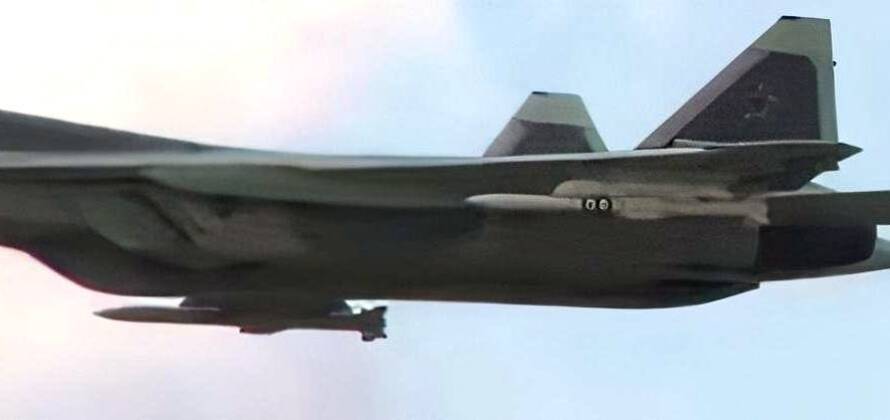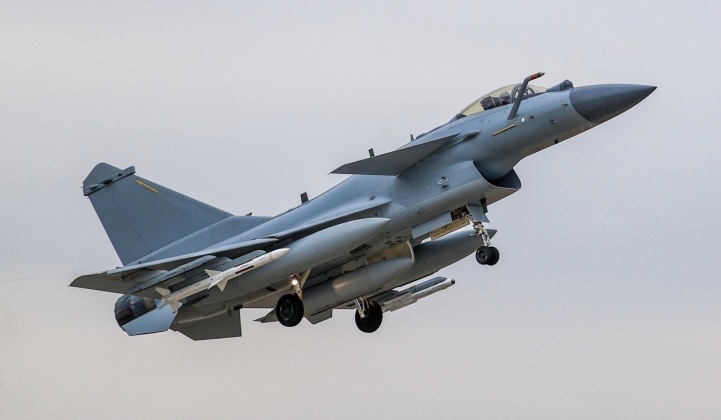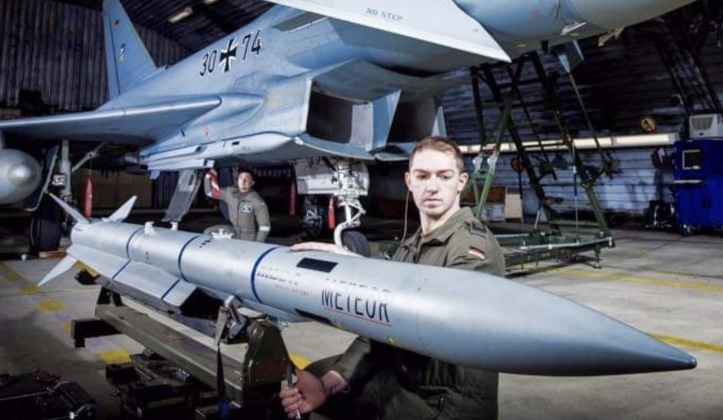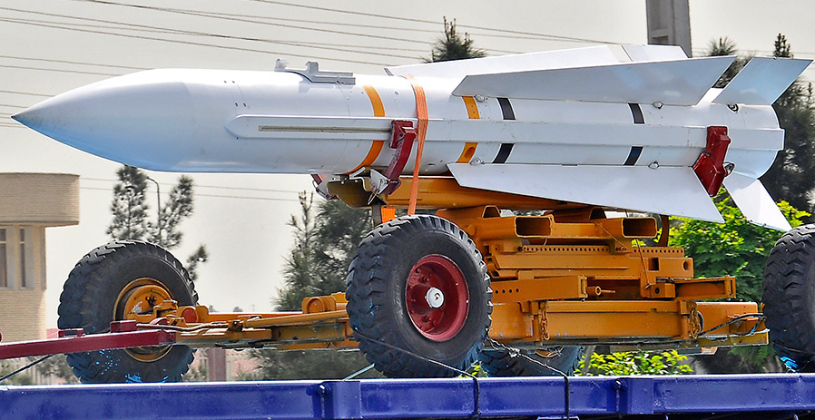News
World’s Top Seven Most Dangerous Standoff Air to Air Missiles: From European Meteors to Russian R-37s
Since the early 1950s air to air missiles have been increasingly envisaged as representing the future of aerial combat, and following the first use of infrared guided visual range missiles in 1958 over the Taiwan Strait longer ranged radar guided missiles were heavily invested in by all major aviation powers to engage targets tens of kilometres away. In the 21st century the capabilities of a fighter’s long range air to air missiles are a key determinant of how well it can perform in combat, whether intercepting large targets such as bombers or tackling other fighter sized jets. Although some analysts have argued that in a protracted war between major powers visual range combat may be more relevant as wide ranging countermeasures quickly nullify the lethality of long range attacks, the capabilities of beyond visual range missiles still remain a key indicator of the capabilities of a military aviation power and one of the key determinants in the balance of power in the air. Although post-Cold War missile designs have seen almost no combat tests against manned aircraft due to the relatively limited incidences of air to air combat worldwide, a ranking and assessment of the seven most capable currently in service across the world is given below based on what is known of their performances and the capabilities of the defence sectors that produced them.
PL-XX – China
Entering service around 2015 alongside the short ranged PL-10 and long ranged PL-15, the PL-XX is the most mysterious of China’s new generation of air to air missiles and by far the largest. Where the PL-15 is the primary armament for Chinese fighters to engage similarly sized manoeuvrable targets, the PL-XX was intended to engage larger more valuable targets at much further distances. These include enemy bombers, tankers, transports and airborne early warning aircraft among others, which play a central role in the operations of many potential adversaries such as the United States and Japan. The PL-XX reportedly has a 500km range, by far the longest in the world, and uses both a large AESA radar and infrared sensors which make it much more difficult to evade or spoof with either flares or electronic countermeasures. The missile is too large to be deployed in numbers, with heavyweight fighters such as the J-11BG and J-16 thought to be able to carry only two each without overly compromising their flight performances. The PL-XX is very likely the most dangerous air to air missile in the world, and remains very potent in its niche role with no equivalents elsewhere in the world.

R-37M – Russia
The R-37 began development in the late 1980s to equip the Soviet Air Defence Forces’ highly promising new generation of heavyweight interceptors the MiG-31M, although with the program canceled in 1994 plans to use the missile to modernise older generations of MiG-31s failed to materialise due to economic crisis. It was only in the early 2010s when MiG-31s began to be modernised with next generation avionics and sensors, including a radar derived from the MiG-31M’s Zaslon-M, that the R-37 began to enter service in improved form as the R-37M. While six can be carried by each MiG-31, fighter sized aircraft such as the Su-35 and Su-30SM can also deploy up to four of the missiles each. The ability of the sensors of smaller aircraft to make full use of the missiles without sharing targeting data with other assets remains questionable however. The R-37M is the world’s fastest known air to air missile with a Mach 6 speed, carries a very large 60kg warhead, and can engage targets up to 400km away. The missile is manoeuvrable enough to be able to neutralise fighter sized aircraft, but is also highly potent against support aircraft such as tankers.

K-77M – Russia
With Russian development of new generations of standoff air to air missiles having slowed. considerably after the collapse of the Soviet Union, leaving the bulk of fighter units reliant on the Soviet era R-27 without active radar guidance, the K-77M missile was developed to revolutionise the performance of a new generation of Russian fighters. Designed with clipped fins to be able to deploy from stealth fighters’ internal weapons bays, the missile has a respectable 200km range and is one of the few to use an AESA radar for guidance. Among standard sized missiles for fighter sized aircraft it is widely considered the most capable, although it has only been seen in a single Russian fighter unit that is well below full strength. The missile is optimised to target small and agile aircraft, and uses a nose mounted active phased array antenna (APAA) guidance system which gets around fighters’ ability to evade missiles’ ‘fields of view’ and gives it likely the longest ‘no escape range’ of any air to air missile. Russian state media outlet RT explained the K-77M’s APAA technology as follows: “An active phased array antenna consists of a large number of cone-shaped cells installed under a transparent-to-radio-waves cap on the nose of the missile. Each cell receives only a part of the signal, but once digitally processed, the information from all cells is summarised into a ‘full picture,’ enabling the K-77M missile to immediately respond to sharp turns of the target, making interception practically inevitable.” A weakness in the design remains that it has yet to be widely fielded, with its affordability for the cash strapped Russian Air Force remaining highly questionable.

PL-15 – China
Entering service from around 2014, the PL-15 was one of the first air to air missiles to use an AESA radar for guidance and has an estimated range of 200-300km. The missile is very widely used by almost all Chinese fighter units to enter service since the mid 2010s, and although intended to equip its J-20 fifth generation fighters is also used widely by its J-16, J-10C and modernised J-11BG fighters. The missile is loosely derived from the PL-12 which entered service in the early 2000s and was its direct predecessor, but lacked an AESA radar and had a much shorter 100km range. A growing portion of China’s fighter fleet is employing the PL-15, not only as new generations of aircraft replace older once, but also as older aircraft such as the J-11Bs receive new sensors and avionics which make them compatible with the advanced missile. The PL-15 is also reportedly compatible with China’s JF-17 Block 3 very light fighters which were designed for export, and compensates for the aircraft’s limited flight performance with a very potent beyond visual range capability. The rate of development in China’s defence industry and in military aviation in particular indicates that a successor to the PL-15 could be forthcoming in the late 2020s or early 2030s, and that the missile itself is likely to see signifiant improvements to its performance until then. Where the PL-12 was seen to have leapfrogged the U.S. Air Force’s AIM-120B air to air missiles and provided a peer level competitor to the latest AIM-120C in the 2000s, the PL-15 has provided an important advantage to which the U.S. specifically responded with development of a new generation of missiles, the AIM-260, that have yet to enter service.

Meteor – Europe
Developed jointly as a pan-European program by Britain, Germany, Sweden, France, Italy and Spain, the Meteor missile was designed with the goal of outperforming the American AIM-120, although it reportedly benefitted from key American technology transfers. While none of the developers other than France had experience developing long range air to air missiles, and the performance of the top French missile the MICA was considered underwhelming compared to its top American and Russian competitors particularly in regards to its engagement range, the Meteor had an impressive performance reflecting the tremendous investment put into the design. Its cost effectiveness, however, remained highly questionable with the missile increasingly considered unaffordable for widespread use as air forces on the continent remain slow to adopt it. The missile gained an initial operating capability in 2016, boasting a superior range and overall kinematic performance than the American AIM-120, and has a number of outstanding features including a propulsion system that more closely resembles that of a cruise missile than traditional air to air missies due to its reliance on a variable flow ducted rocket (ramjet) in place of a rocket motor. This allows the Meteor to throttle its engine in flight, rather than expending its energy in a single unmodulated burn cycle. It can thereby maintain more energy for its terminal attack phase to perform extreme manoeuvres and climb fast. As a result the Meteor is considerably more difficult to evade than the AIM-120 and has a significantly larger ‘no escape zone.’ The Meteor is considered the most capable air to air missile in the Western world, although despite how long it took to develop and its tremendous cost it is widely expected to quickly be overtaken as the U.S. moves beyond the AIM-120 to field its own next generation air to air missile and restore its traditional lead.
AIM-120D – United States
Entering service from 2014, the AIM-120D is expected to be the last variant of the AIM-120 missile which first entered service in 1991 before the class is succeeded by the AIM-260. The missile was initially intended to use an AESA radar like the Chinese PL-15, with the two entering service within months of one another, although this was scrapped to reduce costs. The missile very significantly extended the range the AIM-120 design, which had been around 70km for the AIM-120A/B and 100km for the first AIM-120C variants, but grew to an estimated 160-180km for the AIM-120D. Although its lack of an AESA radar left it more vulnerable to electronic warfare, the missile has improved electronic warfare countermeasures than its predecessors. Unlike the Meteor or Russian K-77M, the AIM-120D is considered affordable and has been very widely deployed within the U.S. Military – although its very long range means only fighters with modern electronically scanned array radars are able to make effective use of it. The AIM-120D inherits the AIM-120C’s clipped fins to be carried internally by stealth fighters, and forms the primary air to air armament of the F-35, F-15EX and F-18E Block 3 fighters which are currently in production for the U.S. Military.

Fakour 90 – Iran
The Fakour 90 is an Iranian derivative of the American AIM-54 Phoenix missile which was delivered to the Iranian Air Force in the 1970s, and was considered far ahead of its time and by far the most capable air to air missile of the Cold War era. The Phoenix was the first in the world to use active radar guidance for air to air combat. Although the AIM-54 has since been retired by the U.S. Navy and the Iranian Air Force, which were its only two operators, the Fakour 90 improves on its capabilities considerably and has been used to modernise Iran’s most capable fighter the F-14 Tomcat. The F-14 is the only Western fighter heavy enough to effectively used the AIM-54 or the Fakour 90 due to their sheer sizes, and two squadrons form the elite of the Iranian Air Force and represent its only two units with viable beyond visual range air to air capabilities. The Fakour 90 improves on the AIM-54’s range of around 190km, reportedly bringing this to around 250km while retaining the original missile’s high Mach 5 speed. With the AIM-54 having proven extremely potent in the Iran-Iraq War, the missile’s improved derivative provides Iran’s F-14 units with a comfortable range advantage over the fighters of neighbouring countries, although the sophistication of the missile’s electronic warfare countermeasures and whether they are up to 21st century standards remains questionable.












